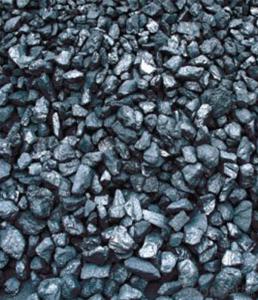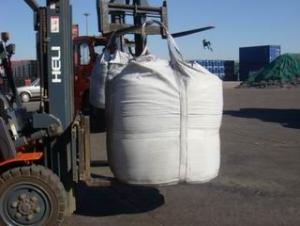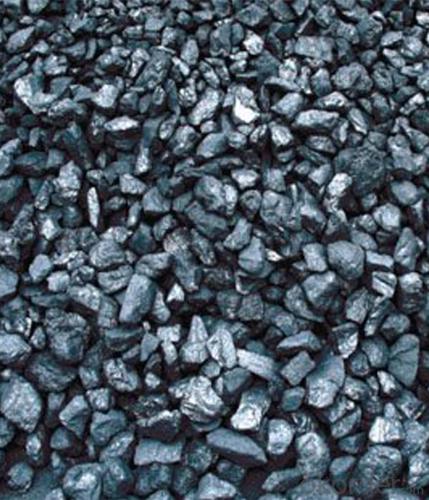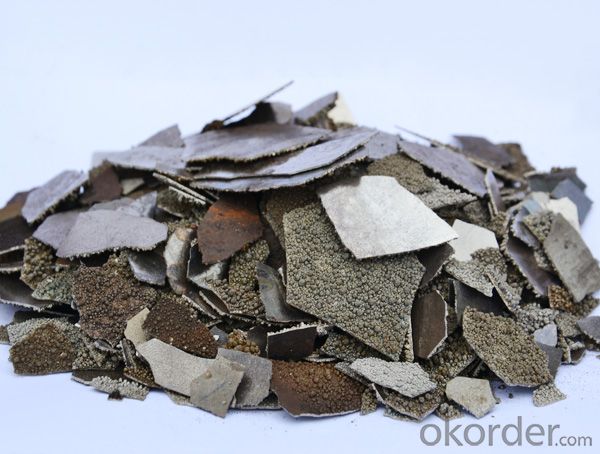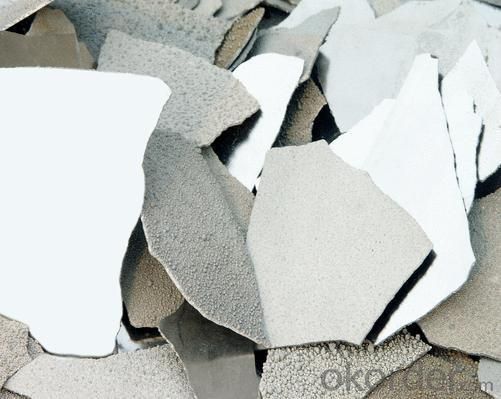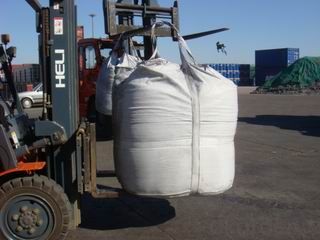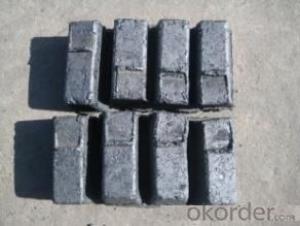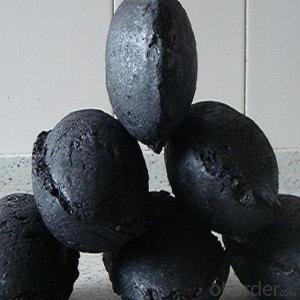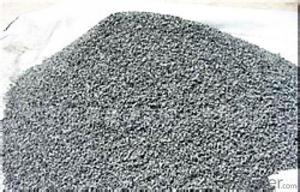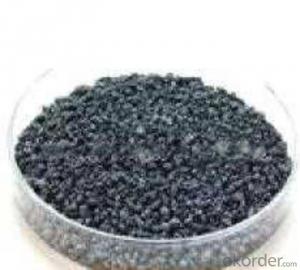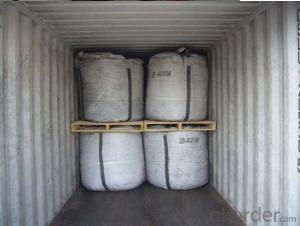FC 92% Calcined Anthracite Used In Steel Making
- Loading Port:
- China Main Port
- Payment Terms:
- TT or LC
- Min Order Qty:
- -
- Supply Capability:
- -
OKorder Service Pledge
OKorder Financial Service
You Might Also Like
FC 92% Calcined Anthracite Used In Steel Making
•Feature:
All of our goods are made in the best quality of world famous Ningxia Taixi Washed Anthracite Coal. All of our products are with High carbon, Low ash, low sulphur, Low Moisture.
•Application:
The Calcined Anthracite Coal/Gas Calcined Anthracite Coal/Carbon Raiser is mainly used in steelmaking in electrical stove, screening water, shipbuilding sandblast to remove rust. It can reduce the cost of steelmaking effectively by replacing the traditional petroleum coke of carburant.Also can improve the Carbon content in steel-melting and Ductile iron foundry.
•Experience:
Our Factories have been producing Carbon additive, Electrically Calcined Anthracite Coal, Calcined Anthracite Coal,Gas Calcined Anthracite Coal for more than 20 years.And we’ve been in carbon products exporting business for more than 10 years before our this company newly established.
SPECIFICATION
PARAMETER UNIT GUARANTEE VALUE | |||||
F.C.% | 95MIN | 94MIN | 93MIN | 92MIN | 90MIN |
ASH % | 4MAX | 5MAX | 6MAX | 7MAX | 8MAX |
V.M.% | 1 MAX | 1MAX | 1.5MAX | 1.5MAX | 1.5MAX |
SULFUR % | 0.5MAX | 0.5MAX | 0.5MAX | 0.5MAX | 0.5MAX |
MOISTURE % | 0.5MAX | 0.5MAX | 0.5MAX | 0.5MAX | 0.5MAX |
Size can be adjusted based on buyer's request.
Package:
1: In MT bags
2: IN 25kgs bags
3: IN 10KG bags
4: or as buyer's request
Pictures of Calcined Anthracite:

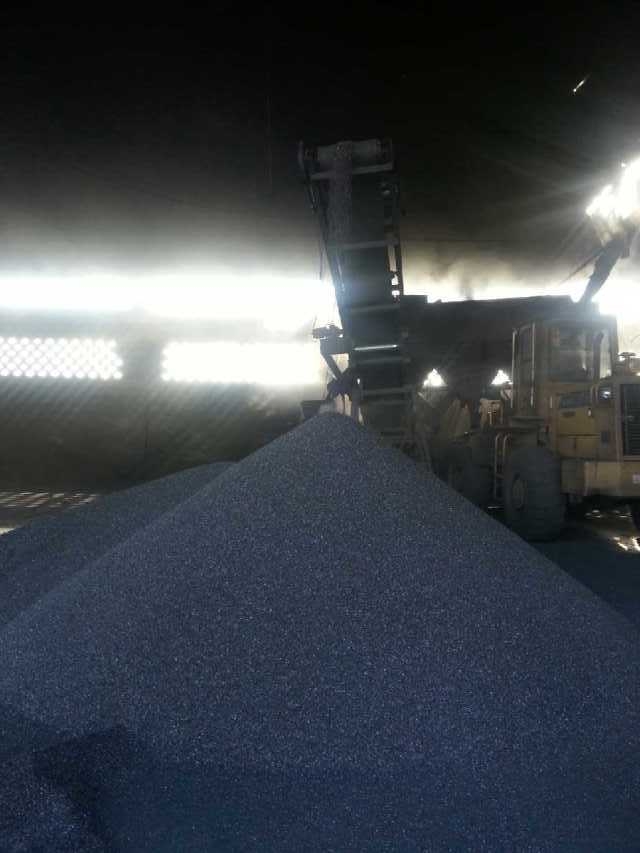
- Q: I don't know the battery. Although I know the former is chemical energy, I want to know if the 1 grain size 5 can compare the charge capacity with the 1 grain 5 1ANot much of a fortune, but thank you very much for the enthusiastic friend who gave me the answer. Thank you!
- The carbon battery voltage is 1.5V, and the rechargeable battery is only 1.2V. That depends on the capacity of the rechargeable battery. You mean 1000MA?
- Q: How are carbon markets regulated?
- Carbon markets are regulated through a combination of international, national, and regional frameworks that aim to ensure the integrity and transparency of emissions trading. One of the main international bodies overseeing carbon markets is the United Nations Framework Convention on Climate Change (UNFCCC), which established the Kyoto Protocol and the Paris Agreement. Under the Kyoto Protocol, an international emissions trading system was created, allowing countries to trade emission allowances through the Clean Development Mechanism (CDM) and Joint Implementation (JI) projects. The CDM and JI projects are approved and monitored by the UNFCCC, which ensures that emission reductions are real, measurable, and additional to what would have occurred without the project. The Paris Agreement, which succeeded the Kyoto Protocol, introduced a new market mechanism called the Sustainable Development Mechanism (SDM). The SDM aims to promote sustainable development and help countries achieve their climate goals by enabling emission reductions and removals through projects in developing countries. At the national and regional level, governments and regulatory bodies play a crucial role in the regulation of carbon markets. They establish legal frameworks, set emission reduction targets, and develop domestic emissions trading systems. These systems typically involve the allocation of emission allowances to companies or sectors, monitoring and reporting of emissions, and the trading of allowances on regulated platforms. To ensure the integrity of carbon markets, strict regulations are put in place to prevent fraud, double-counting, and other forms of market manipulation. Independent verification and accreditation bodies are responsible for auditing emissions data and project methodologies to ensure compliance with the established rules and standards. Furthermore, market oversight and enforcement bodies are established to monitor and enforce compliance with the regulations. These bodies have the authority to investigate and penalize any non-compliance, including imposing fines or revoking emission allowances. Overall, the regulation of carbon markets involves a complex network of international agreements, national legislation, and regulatory bodies. The aim is to create a robust and transparent market that incentivizes emission reductions and supports the transition to a low-carbon economy.
- Q: Yes, I have a weapon, want to strengthen 11, said to be advanced furnace rock carbon, do not know how to get, look at the prawns pointing
- Pro, tell you an unfortunate news, out of the eighty furnace rock carbon, old horse recycling, burning their own boilers, and now we strengthen the use of colorless small crystal block, that is, the colorless small crystal block instead of the original furnace rock carbon.
- Q: How does carbon impact the growth and development of plants?
- Plants rely on carbon to grow and develop, making it an indispensable element. The process of photosynthesis is where carbon plays a critical role in converting sunlight into energy. During this process, plants absorb carbon dioxide from the atmosphere, along with water, to create glucose and oxygen. Glucose acts as the main source of energy for plant growth and is used to construct various molecules like cellulose, proteins, and lipids. Aside from its role in sugars, carbon is also crucial for the structure of plant cells. It forms the foundation of complex organic compounds, including carbohydrates, proteins, nucleic acids, and lipids. These compounds are vital for plant growth and development, participating in processes like cell division, elongation, and the formation of new tissues. Moreover, carbon regulates various physiological and metabolic processes in plants. It influences the opening and closing of stomata, the tiny pores on leaves that control the intake of carbon dioxide and the release of oxygen and water vapor. Carbon also impacts the production of plant hormones, which regulate growth, development, and responses to the environment. Nevertheless, excessive carbon dioxide in the atmosphere, caused by human activities like burning fossil fuels, can negatively affect plants. Elevated levels of carbon dioxide can alter plant physiology by increasing photosynthesis rates and decreasing stomatal conductance. These changes can affect the nutritional quality of plants, disrupt their interactions with pests and diseases, and disturb ecosystems. To summarize, carbon is essential for the growth and development of plants. It is a key component of sugars, organic compounds, and structural elements in plant cells. Carbon is involved in crucial processes such as photosynthesis, cell division, and the regulation of physiological and metabolic functions. However, changes in atmospheric carbon dioxide levels can have positive and negative effects on plants, emphasizing the importance of sustainable practices to ensure the future growth and development of plant species.
- Q: What are the advantages of carbon-based nanoelectronics?
- Several advantages are offered by carbon-based nanoelectronics in comparison to traditional silicon-based electronics. To begin with, exceptional electrical properties are possessed by carbon-based materials such as nanotubes and graphene. They exhibit high electron mobility, enabling them to transport charges at a significantly faster speed than silicon. As a result, electronic devices can operate more efficiently and with increased speed. In addition, excellent thermal properties are exhibited by carbon-based nanoelectronics. They possess the ability to efficiently dissipate heat, thereby reducing the risk of electronic devices overheating. This advantage is particularly beneficial for high-power applications where effective heat management is of utmost importance. Furthermore, carbon-based nanoelectronics have the remarkable characteristic of being extremely thin and flexible. Nanotubes and graphene can be easily manipulated to create electronic components that are ultra-thin and flexible. This allows for the development of innovative devices such as wearable electronics and flexible displays, which were previously unattainable using silicon-based technology. Carbon-based materials also possess a higher mechanical strength in comparison to silicon. They exhibit greater resistance to bending and breaking, resulting in increased durability and longevity. Moreover, carbon-based nanoelectronics hold the potential for scalability. They can be fabricated using various methods such as chemical vapor deposition and solution-based processes, which offer the possibility of large-scale production at lower costs. Lastly, carbon-based nanoelectronics are environmentally friendly. Carbon is a widely available element and does not pose the same environmental concerns as silicon, which requires energy-intensive processes for extraction and purification. In conclusion, carbon-based nanoelectronics offer improved electrical and thermal properties, flexibility, scalability, durability, and environmental sustainability. These advantages make them highly promising for the development of next-generation electronic devices.
- Q: What are the impacts of carbon emissions on the stability of coastal areas?
- Coastal areas are greatly affected by carbon emissions, which create numerous challenges for both the environment and the communities living there. Sea-level rise is one of the most notable consequences, triggered by the melting of polar ice caps and the expansion of seawater due to rising global temperatures. As greenhouse gases like carbon dioxide accumulate in the atmosphere, they trap heat and warm the planet. Consequently, glaciers and ice sheets melt, contributing to the rise in sea levels. Sea-level rise directly endangers coastal regions, leading to increased erosion, flooding, and the loss of valuable land. As water levels climb, shorelines recede, eroding beaches and cliffs, and jeopardizing coastal infrastructure and habitats. This erosion not only threatens the stability of coastal ecosystems but also puts human settlements at risk, resulting in the displacement of communities and property loss. Additionally, the surge in carbon emissions causes ocean acidification, as excess carbon dioxide is absorbed by the ocean, decreasing its pH levels. Acidic waters have detrimental effects on marine life, particularly coral reefs, shellfish, and other organisms that rely on calcium carbonate for their shells and skeletons. With increased ocean acidity, these organisms struggle to form and maintain their protective structures, ultimately leading to the degradation of coastal ecosystems and loss of biodiversity. Furthermore, carbon emissions intensify extreme weather events like hurricanes and tropical storms. Warmer ocean temperatures provide more energy for these storms, making them stronger and more destructive. These events can cause significant damage to coastal infrastructure, including buildings, roads, and utility systems. Moreover, they can result in loss of life and livelihoods, further increasing the vulnerability of coastal communities. In conclusion, carbon emissions have extensive impacts on the stability of coastal areas. Sea-level rise, ocean acidification, and the intensification of extreme weather events all contribute to the deterioration of coastal ecosystems, loss of biodiversity, erosion, and coastal flooding. These consequences not only threaten the environment but also pose significant risks to human settlements. Urgent measures for mitigation and adaptation are necessary to safeguard coastal areas and the communities depending on them.
- Q: Why is the longer the carbon chain, the better the hydrophobic properties?
- The carbon chain is the water chain, but the lower the polarity (TA)They have to write fifteen characters ah from702853 (station link TA) can theoretically explain it zhoupeng87 (station link TA) should be the basic alkyl is not hydrophilic, it belongs to the hydrophobic group, the increase of carbon chain length of the hydrophobic whyy0113 (station TA) carbon chain is longer, the more polar groups easily entrapped nature shows hydrophobic alkane name small Jia (TA station) the carbon chain length of hydrophobic chain length, of course, hydrophobic. Cher (station TA) the alkyl chain is hydrophobic, so the longer hydrophobic part content more hydrophobic natural good red sandalwood fragrance (TA station).
- Q: How does deforestation contribute to carbon emissions?
- The role of deforestation in contributing to carbon emissions is significant. When forests are cleared or burned, the carbon stored in trees and vegetation is released into the atmosphere as carbon dioxide (CO2), a greenhouse gas that contributes to global warming. Forests act as natural carbon sinks, absorbing CO2 from the atmosphere through photosynthesis. Trees and plants convert CO2 into oxygen and store the carbon in their trunks, branches, leaves, and roots. This process helps regulate the Earth's climate by reducing the concentration of CO2 in the atmosphere. However, deforestation disrupts this natural carbon storage system. The carbon once stored in trees and vegetation is released back into the atmosphere, increasing the concentration of CO2. Burning forests exacerbates this process, releasing even larger amounts of carbon through the combustion of trees and plant material. The loss of forests also leads to a decrease in biodiversity and the destruction of habitats for numerous species, which disrupts the delicate balance of ecosystems. As a result, these ecosystems become less efficient at absorbing and storing carbon, further contributing to increased carbon emissions. Moreover, deforestation indirectly contributes to carbon emissions through various means. For example, when trees are cleared, the exposed soil is exposed to sunlight and heat, causing it to dry and release stored carbon. Additionally, deforestation often leads to the conversion of land for agricultural purposes, such as livestock farming or palm oil plantations, which can increase methane emissions, another potent greenhouse gas. To summarize, deforestation contributes to carbon emissions by releasing stored carbon, disrupting the natural carbon storage system, and indirectly contributing to the release of other greenhouse gases. It is crucial to address deforestation and promote sustainable land management practices to mitigate the effects of climate change and reduce carbon emissions.
- Q: What are the carbon monoxide collection methods?
- It can only be collected by drainage. Carbon monoxide is not soluble in water. Because carbon monoxide is poisonous and the density is very close to the air, it can not be collected by exhaust air
- Q: What is carbon pricing?
- Carbon pricing is a market-based strategy aimed at reducing greenhouse gas emissions by putting a price on carbon dioxide and other greenhouse gases. It involves either implementing a tax on carbon emissions or establishing a cap-and-trade system where companies are allotted a certain amount of emissions permits that can be bought and sold. The goal is to create financial incentives for industries to reduce their emissions and transition to cleaner and more sustainable practices.
Send your message to us
FC 92% Calcined Anthracite Used In Steel Making
- Loading Port:
- China Main Port
- Payment Terms:
- TT or LC
- Min Order Qty:
- -
- Supply Capability:
- -
OKorder Service Pledge
OKorder Financial Service
Similar products
Hot products
Hot Searches
